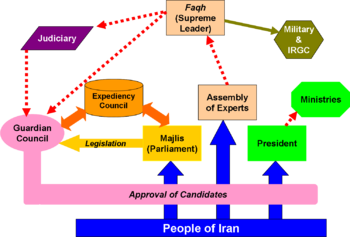State of Iran
The current State of Iran is the world's only theocracy in charge of a major country. In principle, it is a system with checks and balances, although much more complex than a system that simply has a Parliament and judiciary, or Executive, Legislative and Judiciary.
Besides the basic idea of checks and balances among powers, there are additional bodies that check that all governmental actions comply with Islamic principles. These decisions must come from clerics, under the principles of wilayat al-faqih and sharia.
Penultimate clerical authority is vested in the Supreme Leader or faqh, who is appointed and could be removed by the Assembly of Experts. He is considered the most authoritative jurisprudent under wilayat al-faqih. The head of state, not the President, commands the military and Iranian Revolutionary Guard Corps (IRGC).
The President, Parliament, and Assembly of Experts are elected, but from a slate approved by the clerical Council of Guardians, which is appointed by the Supreme Leader and Judiciary.
Head of State
- See also: Iranian Security Forces
The Iranian Government is a complex theocratic republic, with a powerful head of state, the Supreme Leader or faqh, who is a cleric and derives his authority from the principle of Wilayat al-faqih. The Supreme Leader directs the Iranian Security Forces, although the President routinely directs of the Ministry of Interior and the police. He is appointed for life, but in principle could be removed, by the Assembly of Experts, ''Majles-Khebregan.
Ali Khameini is the incumbent, who followed the late Grand Ayatollah Ruhollah Khomeini.
Head of Government
The President is the head of government (not including the military). He is directly elected, but candidates are approved by the Council of Guardians. A president may serve two consecutive terms and a nonconsecutive third term.
Mahmoud Ahmadinejad is the incumbent, last held 12 June 2009 in a highly contested and challenged 2009 Iranian Presidential election. Officially,he received 62.6% and his main opponent Mir-Hosein Musavi-Khamenei 33.8%.
Parliament
There is an elected Parliament, the Majlis. It has 290 seats. Iranian political parties are not well developed, but the membership can be divided into conservatives/Islamists 167, reformers 39, independents 74, religious minorities 5, other 5[1]
Political parties and influence groups
Most conservatives still prefer to work through political pressure groups rather than parties; often political parties or coalitions are formed prior to elections and disbanded soon thereafter/
A loose pro-reform coalition called the 2nd Khordad Front, which includes political parties as well as less formal groups and organizations, achieved considerable success in elections for the sixth Majles in early 2000; groups in the coalition included the Islamic Iran Participation Front (IIPF), Executives of Construction Party (Kargozaran), Solidarity Party, Islamic Labor Party, Mardom Salari, Mojahedin of the Islamic Revolution Organization (MIRO), and Militant Clerics Society (Ruhaniyun); the coalition participated in the seventh Majles elections in early 2004; following his defeat in the 2005 presidential elections, former MCS Secretary General and sixth Majles Speaker Mehdi Karubbi formed the National Trust Party; a new conservative group, Islamic Iran Developers Coalition (Abadgaran), took a leading position in the new Majles after winning a majority of the seats in February 2004;.[1]
After the 2004 Majles elections, traditional and hardline conservatives attempted to close ranks under the United Front of Principlists and the Broad Popular Coalition of Principlists; several reformist groups, such as the Islamic Revolution, came together as a reformist coalition in advance of the 2008 Majles elections; the IIPF has repeatedly complained that the overwhelming majority of its candidates have been unfairly disqualified from the 2008 elections.
Approval of Candidates and Laws
The twelve-cleric Council of Guardians or Shora-ye Negaban-e Qanun-e Assass approves all candidates for direct election, including the Parliament, Assembly of Experts, and President. It consists of six clerics and six jurists who determine if the legislation approved by the Majlis. They determine if legislation from the Majlis is correct according to religious principles.
Dispute resolution
The Expediency Council, Majma-e-Tashkise-Maslahat-e-Nezam, is in charge of mediating disputes between the parliament and the Council of Guardians, and also serves as an advisory council to the Supreme Leader. It also has a degree of supervision over the three governmental branches.
Judiciary
The Supreme Court, Qeveh Qazaieh, and the four-member High Council of the Judiciary have a single head and overlapping responsibilities; together they supervise the enforcement of all laws and establish judicial and legal policies; lower courts include a special clerical court, a revolutionary court, and a special administrative court
References
- ↑ 1.0 1.1 , Iran, The World Factbook, Central Intelligence Agency
